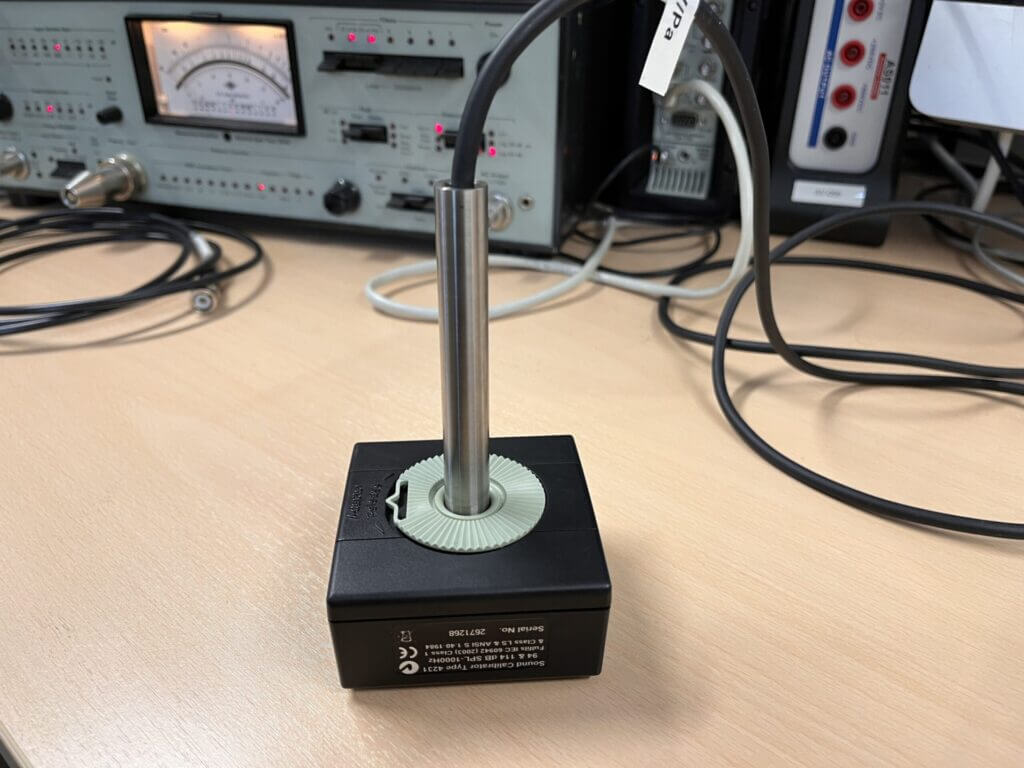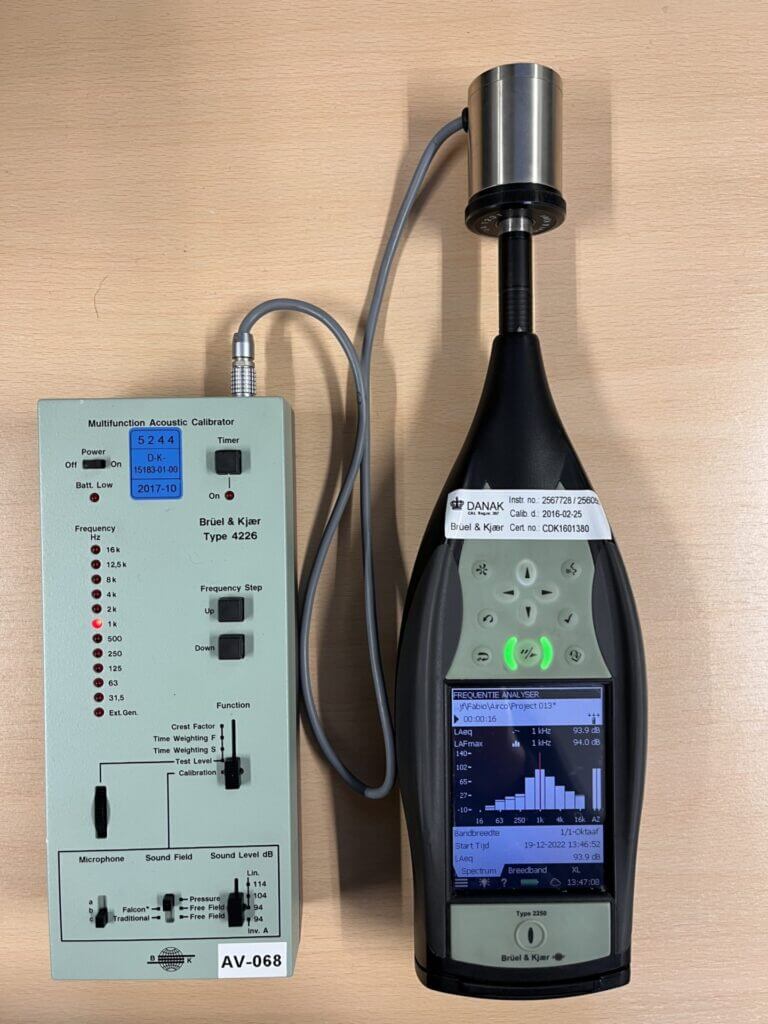Kalibrator. Een akoestische kalibrator t.b.v. kalibreren dient te voldoen aan IEC-60942. De kalibratie van een kalibrator gebeurd volgens Annex B (Periodic tests) van deze IEC-60942 waarbij gebruik wordt gemaakt van een laboratorium standaard kalibratie microfoon (LS). De meeste kalibrators geven een zuivere toon van 94 dB bij 1000 Hz (= 1 Pa t.o.v. 2*10-5 Pa) of 114 dB (=10 Pa t.o.v. 2*10-5 Pa). Pistonfoons geven een geluidsdrukniveau van 124 dB bij 250 Hz (= 31,69 Pa t.o.v. 2*10-5 Pa). Het verschil tussen een kalibrator en pistonfoon is dat bij een kalibrator het kalibratie-signaal elektrisch wordt opgewekt, bij een pistonfoon wordt het kalibratie signaal mechanisch opgewekt. Ons laboratorium maakt gebruik van beide methodes waarbij met een meetonzekerheid van 0,1 dB (bij 1000 Hz) bij een kalibrator en 0,09 dB (bij 250 Hz) bij een pistonfoon.
In Annex B (Periodic tests) van deze IEC-60942 zijn de testen beschreven voor klasse-LS, klasse-1 en klasse-2 kalibrators. Van belang hierbij is dat de meetonzekerheid verdisconteerd dient bij de toetsing aan de ‘accept limits’ zoals genoemd in de IEC 60942. Voor klasse-LS en klasse-1 calibrators met de aanduiding – C – dient gecorrigeerd te worden voor de barometrisch druk ten tijde van de kalibratie, hierbij hoort derhalve ook de kalibratie van de bijbehorende barometer. Voor kalibratie van een kalibrator (calibrator) zijn er twee methoden mogelijk namelijk:
1. Microfoon methode, hierbij wordt gebruik gemaakt van een gekalibreerd laboratorium standaard (druk)microfoon bijvoorbeeld via de – insert voltage technique volgens IEC 61094-2.
2. Calibrator vergelijkingsmethode, hierbij wordt gebruik gemaakt van een gekalibreerde laboratorium standaard kalibrator (calibrator) en een laboratorium microfoon.
De calibrator wordt gekalibreerd op frequentie, geluidsdruk en totale vervorming (22,5 Hz – 20.000 Hz).Bij de kalibratie zijn er drie uitkomsten mogelijk waarvan de IEC 61094 heeft voorgeschreven hoe deze dienen te luiden, ze staan hieronder omgesomd
1. Where public evidence of conformance of the model of sound calibrator to the requirements of Annex A for pattern evaluation was available, and the results of the tests according to Annex B are satisfactory, a statement as follows: ‘As public evidence was available, from a testing organization responsible for approving the results of pattern evaluation tests, to demonstrate that the model of sound calibrator fully conformed to the requirements for pattern evaluation described in Annex A of IEC 60942:2003, the sound calibrator tested is considered to conform to all the class X requirements of IEC 60942:2003.’
2. Where public evidence of conformance of the model of sound calibrator to the requirements of Annex A for pattern evaluation was not available and the results of the tests according to Annex B are satisfactory, a statement as follows: ‘The sound calibrator has been shown to conform to the class X requirements for periodic testing, described in Annex B of IEC 60942:2003 for the sound pressure level(s) and frequency(ies) stated, for the environmental conditions under which the tests were performed. However, as public evidence was not available, from a testing organization responsible for pattern approval, to demonstrate that the model of sound calibrator conformed to the requirements for pattern evaluation described in Annex A of IEC 60942:2003, no general statement or conclusion can be made about conformance of the sound calibrator to the requirements of IEC 60942:2003.’
3. When the sound calibrator does not conform to the requirements of Annex B of IEC 60942:2003 for the designated class for the conditions under which the tests were performed, a statement indicating which tests did not conform.
AV-Consulting Calibration Laboratory kalibreert alle merken kalibrators zoals van BSWA, NTI-AUDIO, BRUEL & KJAER, SVANTEK, RION, CESVA, DELTA OHM, 3M, CEL, ONO SOKI, PCE, VOLTCRAFT. PCB ETC.


